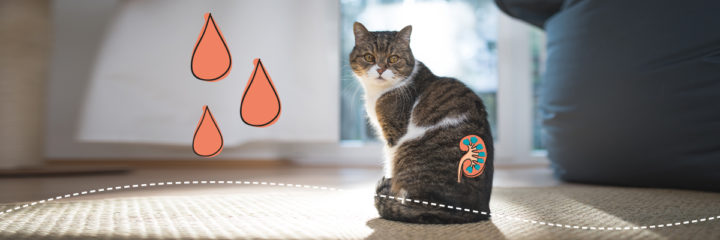
*Advertisement, as brand name mentioned
Uraemic toxins
A friend of mine has look into a new product for cat kidney health that intercepts the precursors of uraemic toxinsToxic, nitrogen-containing urinary substances responsible for uraemia and kidney damage.... generated in the intestines of cats. This has spurred me to take a closer look at the issue of uraemic toxins, a subject I knew little about.
Just what are uraemic toxins?
Uraemic toxins are substances that are poisonous to the kidneys. They are continually formed by protein metabolism in cats’ bodies. The process involves the breakdown of crucial amino acids by intestinal bacteria, causing the formation of uraemic toxin precursors. These precursors are absorbed by the body, converted to uraemic toxins in the liver and are then excreted by filtration of the blood in the kidneys. Hence, uraemic toxins are naturally excreted continuously, each and every day. The kidneys clear toxins from the cat’s body and ensure that uraemic toxins don’t accumulate in the blood. Only when they do indeed accumulate, do they result in health problems.
Uraemic toxins contribute to the vicious of kidney destruction
A great number of papers on the subject of uraemic toxins have been published in human medicine. Uraemic toxins are one reason for blood dialysis in patients with chronic kidney disease. These toxins, which are natural metabolic products, are usually filtered out by the kidneys to detoxify the body. Kidney disease, however, causes uraemic toxins to remain in the blood of patients, as the kidneys are no longer capable of properly detoxifying the body. As toxins, their accumulation in the blood is associated with health problems: the kidneys are attacked by the body’s own toxins and essential filtration units are destroyed. This increasingly exacerbates the problems of chronic kidney disease, as even fewer toxins can be filtered out. A vicious is established, increasing mortality in humans as a result of progressive destruction of the kidneys by uraemic toxins. Dialysis can filter out at least a proportion of the uraemic toxins.
The number one kidney enemy: indoxyl sulphate
However, the best known and, also, most dangerous toxins, indoxyl sulphate and para-cresyl sulphate can’t be filtered out by dialysis. Their accumulation in the blood is associated with an increased mortality. Indoxyl sulphate levels and prognosis are directly linked, or, the higher the levels of indoxyl sulphate in the blood, the worse the prognosis. This relationship has also been demonstrated in other mammals. the underlying science of this link has not been fully established in cats. Scientific research is very expensive, and this means that findings in humans or other mammals often have to be extrapolated to cats. A paper by Chen et al. (2018), seeks to rectify the situation. It demonstrates that, similar to humans, indoxyl sulphate blood levels in dogs and cats with chronic kidney disease increase as chronic kidney disease (CKD) progresses. Indoxyl sulphate is also involved in phosphate metabolism and can result in increased phosphate in the blood, which in CKD cats can further accelerate the progression of the disease and thus reduce life expectancy. In addition, animal experiments in the laboratory have shown that indoxyl sulphate may contribute to anaemia, which is frequently observed in cats with CKD. Although the role of indoxyl sulphate in chronic kidney disease in cats has not yet been investigated as extensively as in humans, it is clearly assumed in the paper by Chen et al. (2018).
The fact that the kidneys lose their ability to remove toxins due to age or illness is reason to consider whether reduced excretion has also raised uraemic toxins in your cat’s body.
In addition to performing a standard kidney profile, since 2015 it has been possible to test your cat by means of a “SDMA test” to provide information on the condition of its kidneys. Repeated findings of concentrations above 14 µmol/l indicate reduced kidney function. The test offers you a way to become proactive in your cat’s health.
Are adsorbers the solution?
Until now, the only way to reduce these uraemic toxins was indirectly by reducing protein in a cat’s food (kidney-friendly diets). Recently, a more targeted approach has emerged independent of the contents of food: selective medications that lower uraemic toxins by adsorbing and eliminating their intestinal precursors. The approach has the advantage that the kidneys need to excrete fewer toxins. This increases their “capacity” to excrete other breakdown products and urinary substances. Being able to adsorb and, above all, excrete uraemic toxin precursors brings several benefits: the burden on kidneys is relieved and this allows them to excrete greater amounts of other breakdown products, while simultaneously the kidneys are protected from injury due to uraemic toxins, which normally contributes to progressive kidney destruction, increased blood phosphate and anaemia (reduced levels of the red blood pigment haemoglobin) – all without the cat suffering any loss of vital proteins. Cats are after all obligatory carnivores. Their entire metabolism is geared towards protein digestion. If their food contains too little protein, they start to break down their own muscles.
*As this article contains named active substances, I am marking this article as an advertisement
Bibliography:
- C.N. Chen et al. / The Veterinary Journal 232 (2018) 33–39


